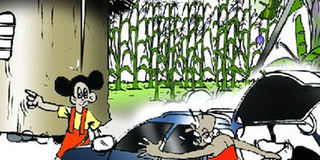Parents should connect their tech-savvy children with reality

“Mummy, hii ni nyumba ya ng’ombe?”. Illustration/IGAH
What you need to know:
- Just as they stepped out of the house, the little boy innocently asked her mother, “Mummy, hii ni nyumba ya ng’ombe?”
- His mother almost fainted with shock, worried that their hosts may have overheard the question.
- While today’s city child is much more enlightened than we were at their age, the fact is that they are frighteningly ignorant about some things
A few weeks ago, a friend went to visit relatives upcountry.
The last time she was there, her four-year-old son was only one, and hadn’t started walking yet, so she figured that this time round, the adventurous boy would get to appreciate the laid back environment of shags.
The people at home happily welcomed them, and since this friend had made her visit known, they found a feast laid out for them in one of her uncles’ home. As they enjoyed the meal, her son told her that he needed to pee.
Just as they stepped out of the house, the little boy innocently asked her mother, “Mummy, hii ni nyumba ya ng’ombe?” He wanted to know whether the house was a cow shed.
His mother almost fainted with shock, worried that their hosts may have overheard the question.
You see, this friend’s neighbour keeps cows, and her son, like most children his age, is fascinated with animals, and often visits the elderly neighbour’s home to gaze at the cows, which are kept in a shed made of timber.
It is at that moment that it occurred to this friend that having been born and raised in the city, save for that one time he’d visited upcountry, (and it doesn’t count because he was too young then) he’d never seen a timber house and, therefore, assumed that all houses were built with stone.
POTENTIALLY EMBARRASING QUESTION
Thankful that her son had asked this potentially embarrassing question out of earshot, she pulled him further away from the house and patiently explained that not all people live in stone houses.
She also made a mental note to ensure that her son, (and any other children she’d have in future) visited upcountry more often, to get exposed to more than malls and flushable toilets.
Sticking to the subject of cows, do you know that most kindergarten children (at least those in my son’s school) think that milk comes from the supermarket? I learnt this when I visited his school last term to check on his progress. In a class of about 15 children, only my son knew that milk comes from a cow – one of his grandmothers keeps a few, and has let him “milk” on several occasions.
If this is the case, I wouldn’t be surprised if there are some children who believe that cows actually talk, thanks to that New-KCC advertisement. Even worse, it could be that some have never seen a cow “live live” and the only chicken they’ve ever laid their eyes on is the one their mother serves them at home, or the two-piecer from KFC or Nandos.
Now, I’m not suggesting that you dig a pit latrine in your backyard or lawn, and force your children to use it occasionally, in the name of acquainting them with reality, but surely, shouldn’t our children know what the source of the meat they eat every day looks like? Or that there are more sources of fire besides your gas or electrical cooker?
For what purpose? You may ask, after all, timber houses and pit latrines are not their reality, furthermore, what are their future chances of having to light up a fire to prepare a meal? To this I ask, “Why not?”
While today’s city child is much more enlightened than we were at their age, thanks to technology and all things nice, the fact is that they are frighteningly ignorant about some things.
Some of you may argue that these things are negligible and, therefore, not worth knowing, but from where I sit, it never hurts to know even those reja reja things.
[email protected]; Twitter: @cnjerius





